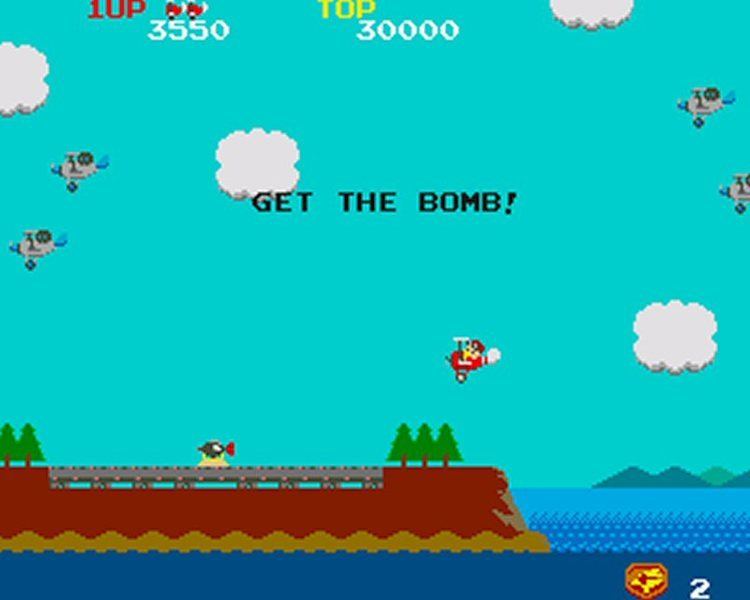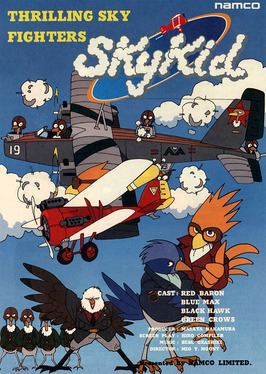Composer(s) Junko Ozawa Initial release date 1985 | ||
 | ||
Genre(s) Horizontal scrolling shooter Mode(s) Up to 2 players simultaneously Cabinet Upright, cabaret, and cocktail CPU 1x Motorola M6809 @ 1.536 MHz,1x Hitachi HD63701 @ 1.536 MHz Platforms Wii, Arcade game, Nintendo Entertainment System, Nintendo 3DS, Wii U, Super Cassette Vision, Cassette Vision Publishers Namco, SunSoft, Inc., Epoch Co., Bandai Namco Entertainment, Namco Bandai Games America Inc. Similar Namco games, Shooter games | ||
Sky kid 1985 namco mame retro arcade games
Sky Kid (スカイキッド, Sukai Kiddo) is a horizontal scrolling shooter arcade game that was released by Namco in 1985. It runs on Namco Pac-Land hardware but with a video system like that used in Dragon Buster. It is also the first game from Namco to allow two players to play simultaneously. The game was later released on the Famicom (brought to the American NES by Sunsoft), and both this version for the Wii, Nintendo 3DS and Wii U and the original arcade version for the Wii were later released on Nintendo's Virtual Console service.
Contents
- Sky kid 1985 namco mame retro arcade games
- Sky kid nes james mike mondays
- Gameplay
- Development
- Other appearances in media
- References

A sequel named Sky Kid Deluxe was released in 1986. It introduced several new enemies and missions, was the first game to run on Namco's then-new Namco System 86 hardware, and was also the first game from the company that used a Yamaha YM2151 FM sound chip.

Sky kid nes james mike mondays
Gameplay

Sky Kid is a two-dimensional scrolling shooter game. The players take control of the Sky Kids, "Red Baron" and "Blue Max", which are references to Manfred von Richthofen, the famous World War I flying ace, and the prestigious order Pour le Mérite informally known as Blue Max. The Sky Kids fly around in biplanes and are assigned specific targets during the missions. These missions involve bombing specific targets. The "A" button is used to control the plane's machine gun and the "B" button is used to perform a loop. A number of obstacles face the players in each level. First, their biplane is not equipped with a bomb to complete their mission and must be picked up en route to the target. Second, there are both ground and air units that attempt to keep the Sky Kids from accomplishing their mission. Last, the Sky Kids may have to navigate through some very inhospitable terrain or navigate around cities in order to get to the target. The targets which the Sky Kids must bomb will either be fortress complexes, or ships. As the players advance further up in the 21 missions, multiple targets will begin to appear in the course of one mission. Players receive points for destroying air and ground targets, and receive additional points at the end of the mission for how many of these types of targets are destroyed. In addition, players get points based on how much of the target is destroyed - but only total destruction warrants an end-of-mission bonus.

Occasionally, performing a loop over a billboard will reveal one of four hidden Namco characters: Pac-Man, Inky, the Special Flag from Rally-X (which, like the Galaxian flagship, has appeared in several other Namco games) or Pooka from Dig Dug.

If the player performs a loop in front of the three dancing girls which appear at the end of each mission, the girls will send out hearts representing kisses. If the player should shoot the girls, or hearts, they will turn into pink powder puffs and waving dogs respectively.
Development
After Namco ended its partnerships with both Midway and Atari, they started to release games in the United States. Releases such as Grobda (1984) and Dig Dug II (1985) were some of the games that Namco released. Since the Video Game Crash of 1983 had claimed quite a few arcade companies, Namco managed to fill the gap. Sky Kid was a game that didn't enjoy great success in the United States. The game, however, did show that Namco was on the right track as far as the games they had released went. Featuring cartoon-like graphics and different types of missions, Sky Kid would form the basis for several other Namco games that are based on the same type of gameplay, such as Ordyne (1988) and Pistol Daimyo no Bōken (1990).
